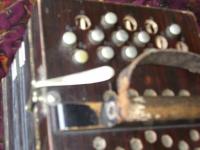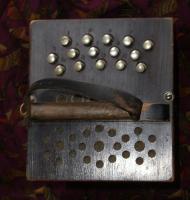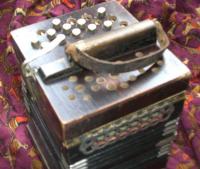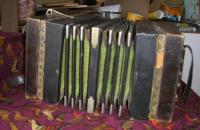-
Posts
878 -
Joined
-
Last visited
Everything posted by Marien
-
This box here http://cgi.ebay.co.uk/AN-OLD-CONCERTINA-AC...1QQcmdZViewItem looks like an early french flutina from Paris, or could this be English? There is no maker's name. Anybody who has an idea of this kind of box and its possible age??
-
Just check www.ebay.com and then search for "thomas squeeze box" in antiques.
-
I did the same but it's still there, it's gone up to 1025 now.
-
Hallo Christian. I did not place a bid at the end. I think you will usually see no wood on the bellows, but leather and chamois leather. In the concertina's I have seen the bellows frames are not ebony or rosewood. Where small peaces of leather are missing near the ends, you may see a tape of linen (on which the leather is glued), and if that is gone you may see the (cheaper type of) wood of the frame. Maybe the same type of wood as the 6 corner blocks that hold the reed pan, or just spruce. For a match between the bellows and the ends, it may be better to check its age (the serial number on the ends and on the bellows). Also maybe some knows more about the period these bellows papers have been used. See you,
-
It is possible, but the split between the ends does not necessarily indicate a fall. It may also be that all the animal glue has been consumed by a natural enemy (book worm and other micro organisms). It needs reconstruction of the wood I would say, takes time but not the most difficult part of a restauration. The restauration costs depends on what should be done (and who does it). It could need new bellows, the inside is a mystery to me. Hopefully the reed pan is ok and not warped. What to tell about the reeds (rust/brass replacements), springs, pads and valves, screws etcetera. It may be a lot of work, as it looks like it has not been played for a long time. To have it restaured by a professional it could even cost you more than you estimated. To me it looks like an interesting winter project to make it playable again for my own use.
-
An additional note for eventual enthusiastic bidders, I do not know the pitch, one could ask the seller. Many SA instruments are originally tuned in Bb/F. Also I don't know if this one needs a complete overhaul, but I would not be surprised if that would be the case.
-
Thanks to all, especially Chris and Al. Indeed, the felt bushings are too tight. I took of the end and if I hold it against the light I can see the 2 holes are smaller and I can see the felt is thicker. I wil try Chris' method first. Al's method may be something to try when that does not work, but, not having done such thing before I fear that I might roughen up the bushing, making it worse than it was. I guess this only works of the drill is precisely the size of the button + 0.1 mm and razor sharp. Thanks again
-
Al. Solly, maybe I should describe some more. The concertina has been freshly repadded before I got it (about a year ago), and the problem was already there. As I played it a lot, the problem decreased but sometimes it returns on unexpected moments, hopefully it does not on stage. Now the problem is not always there, it seems to be related to air humidity (but I am not sure, today it is working fine and it is raining). When the problem is there, it does not make a difference how I push the button. When I push the bellows and let go the button, that is when it starts (never on pull). It feels like the pad does not want to return 100% in place. I keep hearing the C note (both no push and pull) until a certain moment it's gone (and in my memory it is always dissappearing when I pull the bellows and never when pushing the bellows). As I read all comments, I am striking out the spring problem. The two pads rubbing is possible, as I remember that when I opened it up, the pad was very close to another one. It seems logical that the pad is rubbing or resting on the edge of its neighbour pad until it by coincidence moves to its position, perhaps when pressing the button for the neighbour pad, I am not able to check that now. I inspected all buttons and it seems that two of them are returning slower to their closing position. Most of the buttons pop out very quick, but these two are (just that bit) slower, I can see it mooooving. I hope this does not to confuse you more, but this only happens on push, the note stays just for a fraction of a second. On pull then the button is faster back in its rest position. I think that on pull, the air stream pulls the pad back in position, while on push there is an airstream pushing the pad away from the play. These forces may be weak, but I guess they might just make the difference. In fact there are no big problems today, so I'm going to play a tune now. Cheers.
-
Thanks for confusing me Al, I´ll put bets on both suggestions. If it is the felt, should I feel some constraint when pushing? Marien
-
Hi Geoff, It is not so much of a problem, it plays quite good when I play all day, but sometimes the problem returns. It is on push when it starts to keep open, as if it is blowing the pad open and the spring force is too low to keep it down (it happens faster on rainy days). If is a Lachenal new model 55 button Crane duet with raised black ebony ends, about 1910. The size is slightly bigger than usual (maybe 6,75 inch). As it has lots of reeds so the pans are full, and there is "lots of action". I think you will know this type. It has 3 C keys on the right hand side. The second one of them is the one I mean. The pad is positioned somewhere above the center, quite a long way from the button, almost at the opposite corner of the end. As I started this topic I just had these ideas: Each button is held down by the same force in the middle of the lever (the springs are all the same). If that is right, then I will have to push harder on buttons if they are on a short lever. For longer levers I will have to use less power, if the springs are all the same strength. To reach equal press power for each button, the power of the spring (in the center of the lever) should theoretically be stronger if the lever is longer, and less if the lever is shorter (or am I missing something?). So I was thinking this could be done with 2 springs, as I sometimes see on air releases, or by placing the spring further out of the center of the lever, if there is a good place for it on the action plate. Well I am not sure if this is enough for finding a solution. I'll open the box up anyhow to check if the pad returns precisely to the right position. Marien.
-
This looks like a nice type of 32 button Salvation Army Lachenal. Never seen this one before on ebay, or has someone? It's here. http://cgi.ebay.com/Antique-Lachenal-Anglo...1QQcmdZViewItem
-
They are rare and it's antique collectors that place bids on them, not necessarily players (so I am not going to place a bid either).
-
Me no expert either, but I think it makes sense, thanks.
-
Thanks Al, I didn't think about that, but I guess you ar right. If the lever is longer, the pad goes high into the air and might hit something. I'll check that.
-
Okay, I'll strike out the word good quality. All the same somebody suggested that they have english type reed pans and reeds in individual frames, and that are quite uncommon features for a german concertina. I also do not know about the levers, are they the usual wooden type levers? Do you know these things of the copy you saw?
-
Hello Christian, Have you seen this thread: this thread It shows good quality English concertina's that have been made in Germany a long time ago. Also I heard from a Bandoneon maker in Belgium that in history, German made anglo's exist with english types of action and individual reed frames (far before Suttner's time).
-
To me the best case type is one that keeps it exactly in place, for example with a hexagon shape inside (to keep away the tina from dancing inside its case). To me another favorit design feature would be that, when you pick it the case in a hurry after playing, it should be clear if the lid is eventually not fastened (to keep away the tina form dancing out of its cage).
-
After pushing a certain note, a pad on one of my concertina's stays open sometimes. The pad seems to be ok, but it is on the end of a long lever, so it may be to weak. As I read the spring should move if the pressure on the button is 40 or 50grams. If I look inside then the springs are all quite the same shape and the same number of windings. Should I use 2 springs for long levers? Or is there a better solution?
-
I reported this scam to ebay today, and I keep encouraging anybody else to do the same. But if this is an hijacked account, who can tell? The problem may be that ebay does not like to remove offers from clients with 100% positive feedbacks just like that.
-
Hello Christian, What you say seems ok to me, but I am not German (maybe you will drive through my home town if you take the car to visit Wim Wakker). So, who is going to translate the entire Concertina.net pages into german language? ~{ :0)}= Still I kept thinking, I mean that Louis Lachenal was booked as being clock maker when he arrived in England, as shown in Stephens pages. Does history need more proof that he really was? The sheet indicates that he was a professional clock maker before 1839. OK he was just 18 but, after all, clock maker was his profession in the immigration sheet and child labour (starting as young as you could earn money for the family) was really not uncommon those days. Also I am curious whether the one who made up this german wikepadia page, just has been reading Stephen Chamber´s history page on Louis Lachenal, or somebody who knows more and has other sources of information. Schoenen Tag noch, Marien
-
Of course the box by Carl Eulensteen is much more interesting, but what drew my attention was the Hahn box and the similarity with this one (see pictures). Do you have an idea of the age of this 32 button german concertina (it is one that I plan to restore). If I am correct the button caps are german silver. I think it is not really old, maybe late 19th century? but in fact I have n't got a clue. There is no name or text on the box, except the numbers above the keys. It has a nice warm sound, and it is still good enough to restore it.
-
Perhaps fix the frame upside down to check. If the problem is on the push then it is the reed set. If the problem keeps on pull then it is something else.
-
Another wild guess is that the frame slot may be not 90 degrees and (on the inside of the reed pan) not wide or long enough to let the reed go through. This could be in line with what you describe that at low volume the reed will move free but with loud volume then the reed may get jammed. In that case some filing and polishing could help (?)
-
Correction, Guess he did not come with his parents, I thought I had read that somewhere...
-
All right, I know that Louis Lachenal was born in 1821 approx. and he came to England with his parents in 1839. I hope you understand that it was not me who made up that Louis Lachenal was imported. The source for that was the german language wikepedia site, which does not have a lot of concertina statements and some of them may be doubtful, for example, until yesterday they spelled "lachnel" in stead of "lachenal". Wikepedia suggests that Wheatstone used the technical skills of the Swiss clockmaker Louis Lachenal. I do not know who wrote this in Wikepedia. It is easy to add and change information in Wikepedia, anyone can do so. Here is the link: http://de.wikipedia.org/wiki/Konzertina






